Could you recommend a tree for me?
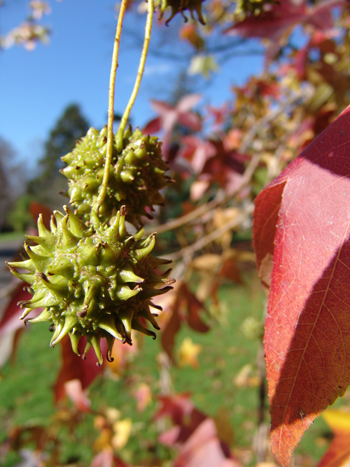
“Could you recommend a tree for me?” is a question I am frequently asked. I routinely follow the question with one of my own. “Where will it go?” The tried and true adage of “right plant, right place” is particularly applicable to tree selection. Are you planting in a small courtyard, or looking for a towering shade tree? It is often said that we don’t plant trees for ourselves; we plant them for our grandchildren. It takes decades for a tree to reach its mature height. Careful planning can insure that the variety selected will be beneficial for both you and the tree. Sweetgum, silverbells, and black tupelo are three underutilized trees that would make ideal candidates for the home landscape.
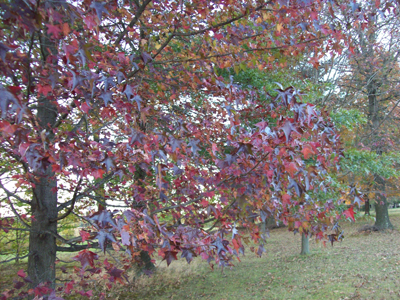
Liquidambar styraciflua. Courtesy of Penncrest Farm.
History says that American sweetgum first appeared in a Spanish work by F. Hernandez, published in 1651, in which he describes it as a large tree producing a fragrant gum resembling liquid amber, hence the latin name Liquidambar sytraciflua. Ranging from New York to Illinois, south to Florida, Texas and Mexico, sweetgum prefers moist soils with a standard pH. Averaging 60-75’ in height, sweetgum is easily recognized by its combination of star-shaped leaves and spiked seed pods. Leaves bear a resemblance to maples, but differ by the glossy, leathery appearance. Autumn brings a spectacular display of color as leaves change to various shades of orange, red, and purple. Inconspicuous spring flowers develop into spiked orbs. Wikipedia lists numerous nicknames: space bug, monkeyball, bir ball, gumball, cukoo bir, and sticky ball are a few. Sweetgum would gain greater favor if not for the fruit, produced in abundance, and unpleasant beneath the foot.
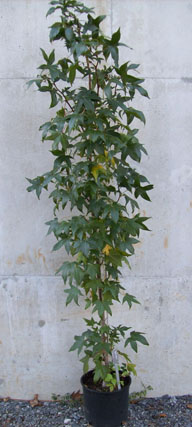
Liquidambar styraciflua 'Slender Silhouette’. photo credit: J. Coceano
Several cultivars, ‘Rotundiloba’ being one, are fruitless. ‘Slender Silhouette’ is a 2011 Gold Medal Award recipient. Bestowed by the Pennsylvania Horticultural Society, Gold Medal plants “will exhibit standards of excellence for pest and disease resistance, as well as ease of growing, when planted and maintained by recommended methods.” While not fruitless, the narrow columnar form will reduce the area affected by seed drop and make fruit collection an easier task. ‘Slender Silhouette’ makes a dynamic vertical exclamation in the landscape. When I was a child, sweetgum fruit was a popular toy. My brother and I would imagine them as crude medieval weapons while our mother had a different view, using them effectively in floral arrangements and seasonal wreaths.
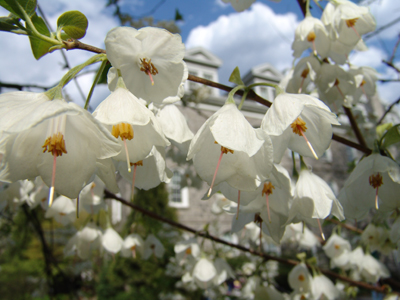
Halesia tetraptera. photo credit: T. Rounsaville
Halesia are spectacular native small trees that deserve far better representation in horticulture. Michael Dirr states “A great tree for understory planting along stream banks, in the back of the shrub border, against a background of large conifers, or as a single specimen, yet uncommon anywhere in American gardens.” Also known as snowbells or silverbells, Halesia is named after Stephen Hales, credited with being the first to accurately describe the movement of water in plants. Several species can be found at the Scott Arboretum including Halesia tetraptera, Halesia monticola ‘Rosea’ and Halesia diptera var. magniflora. Mature specimens can be observed inside the Parrish West Circle, adjacent to Clothier Hall.
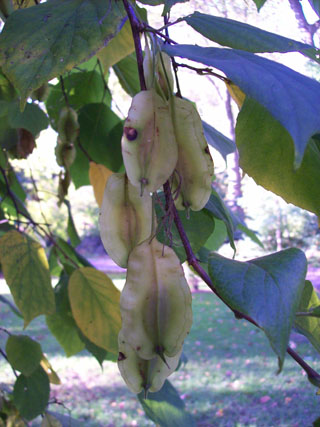
Fruit of Halesia diptera var. magniflora fruit. photo credit: J. Coceano
Tree shape is dependent on the number of trunks. Single-trunk specimens bear a classic tree outline, while multi-trunk trees give a low, shrubby branch profile. In late April and May, the white bell-shaped flowers appear in clusters, usually before leaf break. ‘Rosea’ is a pink-flowered form. When looking for pink forms it is best to observe when in flower as degree of pink can range from near white to rose. Winged fruits dangle from the branches like carefully placed ornaments. Halesia will grow 40-50’ tall in moist, well draining, slightly acidic soils in sun to shade.
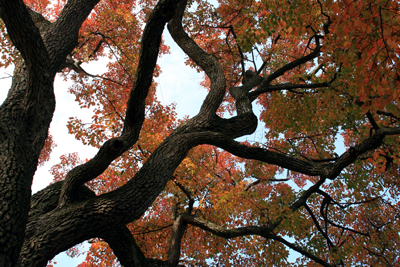
Nyssa sylvatica. photo credit: D. Mattis
Black Tupelo, Nyssa sylvatica, is often the first to herald the autumn season. In late August and into September, Nyssa leaves begin to change from deep green to orange, scarlet, and maroon. Nyssa generally grow 50 to 70’ tall and naturally range from Maine to Michigan, south to Florida and Texas. The trees bear a distinct pyramidal shape that often persists into maturity. Under a full canopy, tupelo bark appears black. Closer inspection yields a distinct bark pattern: deep valleys run the length of the trunk producing a blocky configuration. Dirr notes that “a single specimen is spectacular, but groupings of five to seven trees, each expressing a different fall color, provide pause for reflection.”
The tree is uncommon in the nursery trade, perhaps because it is known for being difficult to transplant due to a dominant tap root. Dirr believes it would be a top-five landscape tree if not for transplant issues. Other sources cite that small balled and burlapped or containerized specimens normally transplant readily. A workhorse in the landscape, Nyssa prospers in dry to swampy soil in full sun situations.
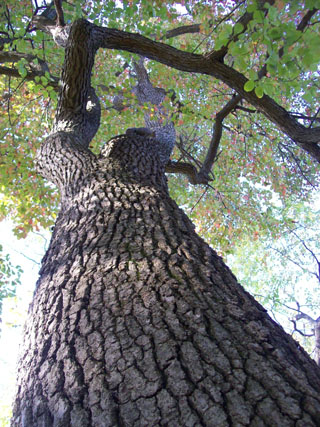
Nyssa sylvatica bark detail. photo credit: J. Coceano
“Could you recommend a tree for me?” Visit the Scott Arboretum and see firsthand an amazing collection of trees. We would be happy to discuss which trees might be a great choice for your situation. The arboretum website contains two publications regarding trees for home landscape use: Recommended Trees for your Home Landscape and Native Trees for the Delaware Valley.
“He who plants a tree plants a hope.”
~Lucy Larcom, Plant a Tree





No Comments